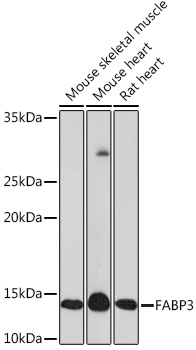Anti-FABP3 Antibody (CAB8789)
- SKU:
- CAB8789
- Product type:
- Antibody
- Reactivity:
- Mouse
- Reactivity:
- Rat
- Host Species:
- Rabbit
- Isotype:
- IgG
- Antibody Type:
- Monoclonal Antibody
- Research Area:
- Signal Transduction
Frequently bought together:
Description
| 抗体名: | Anti-FABP3 Antibody |
| 抗体コード: | CAB8789 |
| 抗体サイズ: | 20uL, 50uL, 100uL |
| 申し込み: | WB IF |
| 反応性: | Mouse, Rat |
| 宿主種: | Rabbit |
| 免疫原: | A synthesized peptide derived from human FABP3 |
| 申し込み: | WB IF |
| 推奨希釈: | WB 1:500 - 1:2000 IF 1:50 - 1:200 |
| 反応性: | Mouse, Rat |
| ポジティブサンプル: | Mouse skeletal muscle, Mouse heart, Rat heart |
| 免疫原: | A synthesized peptide derived from human FABP3 |
| 精製方法: | Affinity purification |
| ストレージバッファ: | Store at -20'C. Avoid freeze / thaw cycles. Buffer: PBS with 0.02% sodium azide, 0.05% BSA, 50% glycerol, pH7.3. |
| アイソタイプ: | IgG |
| 順序: | Email for sequence |
| 遺伝子ID: | 2170 |
| Uniprot: | P05413 |
| セルラーロケーション: | |
| 計算された分子量: | 15kDa |
| 観察された分子量: | 14KDa |
| 同義語: | FABP11, H-FABP, M-FABP, MDGI, O-FABP |
| バックグラウンド: | The intracellular fatty acid-binding proteins (FABPs) belongs to a multigene family. FABPs are divided into at least three distinct types, namely the hepatic-, intestinal- and cardiac-type. They form 14-15 kDa proteins and are thought to participate in the uptake, intracellular metabolism and/or transport of long-chain fatty acids. They may also be responsible in the modulation of cell growth and proliferation. Fatty acid-binding protein 3 gene contains four exons and its function is to arrest growth of mammary epithelial cells. This gene is a candidate tumor suppressor gene for human breast cancer. Alternative splicing results in multiple transcript variants. [provided by RefSeq, Mar 2016] |
| UniProt Protein Function: | FABP3: FABP are thought to play a role in the intracellular transport of long-chain fatty acids and their acyl-CoA esters. Belongs to the calycin superfamily. Fatty-acid binding protein (FABP) family. |
| UniProt Protein Details: | Protein type:Lipid-binding Chromosomal Location of Human Ortholog: 1p33-p32 Cellular Component: extracellular space; sarcoplasm; cytosol Molecular Function:protein binding; icosatetraenoic acid binding; cytoskeletal protein binding; long-chain fatty acid transporter activity Biological Process: response to drug; negative regulation of cell proliferation; cholesterol homeostasis; regulation of fatty acid oxidation; fatty acid metabolic process; response to insulin stimulus; phospholipid homeostasis |
| NCBI Summary: | The intracellular fatty acid-binding proteins (FABPs) belongs to a multigene family. FABPs are divided into at least three distinct types, namely the hepatic-, intestinal- and cardiac-type. They form 14-15 kDa proteins and are thought to participate in the uptake, intracellular metabolism and/or transport of long-chain fatty acids. They may also be responsible in the modulation of cell growth and proliferation. Fatty acid-binding protein 3 gene contains four exons and its function is to arrest growth of mammary epithelial cells. This gene is a candidate tumor suppressor gene for human breast cancer. Alternative splicing results in multiple transcript variants. [provided by RefSeq, Mar 2016] |
| UniProt Code: | P05413 |
| NCBI GenInfo Identifier: | 119802 |
| NCBI Gene ID: | 2170 |
| NCBI Accession: | P05413.4 |
| UniProt Related Accession: | P05413 |
| Molecular Weight: | 14858 |
| NCBI Full Name: | Fatty acid-binding protein, heart |
| NCBI Synonym Full Names: | fatty acid binding protein 3 |
| NCBI Official Symbol: | FABP3 |
| NCBI Official Synonym Symbols: | MDGI; FABP11; H-FABP; M-FABP; O-FABP |
| NCBI Protein Information: | fatty acid-binding protein, heart |
| UniProt Protein Name: | Fatty acid-binding protein, heart |
| UniProt Synonym Protein Names: | Fatty acid-binding protein 3; Heart-type fatty acid-binding protein; H-FABP; Mammary-derived growth inhibitor; MDGI; Muscle fatty acid-binding protein; M-FABP |
| Protein Family: | Fatty acid-binding protein |
| UniProt Gene Name: | FABP3 |
| UniProt Entry Name: | FABPH_HUMAN |
View AllClose


